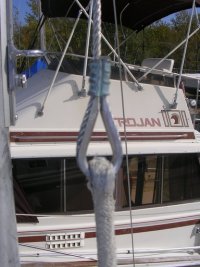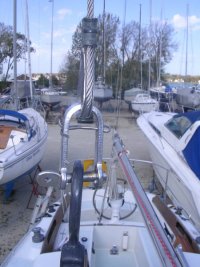Czech Mate
Member II
It appears that it is time to replace a very weathered main halyard on our 1975 E32-2. Last fall I took some measurements and this is what I found. I don't know whether this is original or not and I might not be using the correct terminology, but here goes. What is now on the boat as near as I can tell is a 7/16" diameter rope halyard combined with a 3/16" diameter wire halyard with 2 thimbles. There is a spliced eye on the rope halyard that captures a thimble on one end of the wire and the other end of the wire has a thimble that captures the shackle that attaches to the head of the mainsail. Do these dimensions sound correct?
I talked to the guy that has done rigging for me in the past and asked him what he would be most comfortable with if he had to go up the mast again, which he has done in the past, and his recommendation was a rope to wire halyard. Any thoughts? Attached are some photos of what I have now, Your opinions would be greatly appreciated.
Thanks,
Bill
Czech Mate
Sturgeon Bay, WI
I talked to the guy that has done rigging for me in the past and asked him what he would be most comfortable with if he had to go up the mast again, which he has done in the past, and his recommendation was a rope to wire halyard. Any thoughts? Attached are some photos of what I have now, Your opinions would be greatly appreciated.
Thanks,
Bill
Czech Mate
Sturgeon Bay, WI



